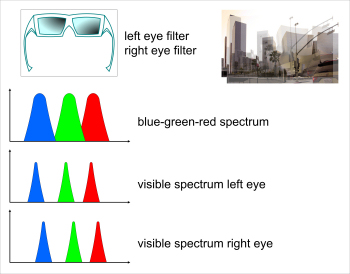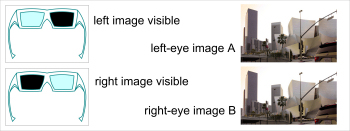3D Cinema
General
3D viewing in reality is based on our two eyes, each catching a slightly different view of the surrounding. Depending on the viewing angle between the two eyes on different parts of the two seen images the distance can be calculated by the brain. 3D viewing with just one eye is impossible.
By viewing with both eyes we shift the right eye slightly to the left and the left eye slightly to the right. The eye lines cross somewhere in front of us. The nearest possible is some 10 to 20 cm and the furthest is in the eternity. Looking at a blank cinema screen these lines are crossing right at the screen surface.
The 3D movie image is created by displaying two images (each for one eye). If parts of the images split further apart, these parts seem to be further away behind the screen, if parts of the image move closer together side by side they seem to be closer and even in the space in front of the screen.
There are three major fields of 3D movie creating:
- artificial computer generated images called CG3D (computer generated)
- 3D camera-captured images of reality
- post production process to create 3D images out of 2D images (2D to 3D conversion)
A Digital Cinema 3D movie, distributed by the 'Digital Cinema Package' (DCP) consists of 48 images per second, 24 for each side (left and right). Each of the 24 images for each side are projected three times to create a 72 fps frame rate for each eye.
For nearly all 3D systems 3-chip DLP projectors are used. Only the 2K resolution (2048 x 1080 pixel) is used for 3D, defined by the Digital Cinema Initiatives, LLC (DCI).
Only the 3D projection system (and the eyeglasses) are different for the different technologies. The source material (the 3D movie) is identical no matter with which system they are presented.
RealD Cinema
circular polarized light - two differently polarized images one after the other - silver screen - polarized passive eyeglasses
|
For the RealD projection only one projector (usually DLP) is needed. It is at the moment world-wide the most widely used 3D technology. RealD uses circularly polarized light. Left-eye and right-eye images are projected individually in an alternative order. The frame rate is usually 144 fps (72 fps per side). The circular polarization is done clockwise for the right eye and counterclockwise for the left eye. The eyeglasses are circularly polarized and on the projector side a liquid crystal polarization filter in front of the projection lens switches polarization between the left-eye and the right-eye frame.
Only the fitting image (polarization direction) can be seen through the glasses and the visible image is switching alternatively left-right-left-right, because each filter passes only that light which is similarly polarized. The polarizing filter reduces the light output into half. Because of the circular polarization (in distinction to linear polarization) head movements are not critical for the visible image.
The high frame rate of 144 fps to get two frame rates of 72 fps per side is needed in comparison to the 3-times shutter for a regular 24 fps movie to create 72 images per second reducing any visible flicker effects. To keep the projected light polarized by reducing the diffusion and to keep the light output as high as possible a silver screen with a high gain is used. RealD is used in the majority of US cinemas.
 | |
|
RealD XLS
circular polarized light - two differently polarized images at the same time - silver screen - polarized passive eyeglasses
RealD XLS is an expansion to RealD. Here both polarized images are shown simultaneously.
Dolby 3D
spectral-filtered light - two different images with different spectral content - regular white screen - passive spectral filter eyeglasses
|
The Dolby 3D system uses a technology that is called wavelength multiplex visualization and is licensed by Dolby. The technology was developed by the German company Infitec which has a long developing history for 3D systems for industrial research laboratories (Daimler Chrysler etc.). The name Infitec was created as an abbreviation for 'Interferenzfiltertechnik'.
To create the two images the light is not polarized as for RealD but both images are created using different spectral components of the visual light. Two projectors are used and two different filters in the two projectors extract two different 'wavelength groups' of red, green and blue light. These two slightly different versions of 'white light' are used for both images and the eyeglasses are equipped with the adequate filters for the left and right eye that let only the appropriate wavelengths pass. Both images are projected on top of each other. Because of the complicated filter technology these eyeglasses are expensive. But as a projection screen the regular white screen can be used, no silver screen is needed. This is a big advantage for cinemas which can use their standard white perforated projection screen. Dolby 3D is used in cinemas worldwide.
Several large cinemas in Germany installed Dolby 3D (Duesseldorf, Cologne).
 | |
|
XpanD 3D
two alternating images - active alternating shutter eyeglasses - only one image seen at the time - regular white screen
|
XpanD 3D uses an active technology that switches between the alternating left and right images by an active-shutter LCD eyeglass. The eyeglasses are controlled by an infrared transmitter in the cinema and receivers integrated in the front part of the eye-glasses. The infrared command orders to shut down the left and right glass one after the other in sync with the projected images.
Both images of the 3D content are shown alternating left-right-left-right and because of the synced shutter in the eyeglasses only one image at the time is seen (left-right-left-right).
XpanD 3D also doesn't need a silver screen and by tilting or moving the head no disturbance is created in the image.
The electronic eyeglasses are relatively expensive and battery-powered. They demand a high amount of management to ensure proper working conditions every time been used. XpanD is used mainly in cinemas in Germany, Austria and Switzerland.
 | |
|



